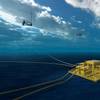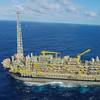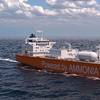Hvide Marine Inc. reported a net loss of $9.6 million for the fourth quarter ended December 31, 2000, on revenues of 80 million. In the year-earlier period, the company had a net loss of 197 million, including charges related to its reorganization, on revenues of $76.8 million. Operating income in the fourth quarter of 2000 was 8.1 million versus an operating loss of $11.8 million in the fourth quarter of 1999.
For all of 2000, the company reported a net loss of $29 million or 2.89 per diluted share on revenues of $320.5 million. In 1999, the Company had a net loss of $249.9 million on revenues of $342.2 million. Operating income in 2000 totaled $25.4 million versus an operating loss of 9.5 million in 1999. The company also announced that, effective March 19, it would change its name to Seabulk International, Inc. and that its stock would begin trading under a new symbol, SBLK, on March 21. Seabulk Offshore is the brand name of the company's biggest and best-known business -- its offshore energy support activities, which operate worldwide and account for nearly half of its revenues.
"We are excited about the name change, which sends the strongest possible signal to our shareholders, customers and employees that we are a new company under new leadership with a new corporate attitude, vision and strategy," commented President and CEO, Gerhard E. Kurz. "The new name symbolically ends the first year and marks the beginning of the second year of the new organization. 2000 was not an easy year, but we made good progress toward our goals of debt reduction, cutting costs, quarter-over- quarter improvement in operating results, and positioning the company for long-term profitability and growth. In addition to paying down nearly 50 million in debt, we invested heavily in vessel maintenance and upkeep so as to take advantage of rising markets in both our offshore and tanker businesses.
"We also invested in the future by contracting to acquire two modern offshore energy support vessels; acquiring 100 percent equity interest in our five U.S.-flag, double-hull tankers by purchasing the remaining 24.25 percent interest held by a third party; and taking delivery of a fourth Ship Docking Module to augment our towing fleet," continued Mr. Kurz. "At the same time, we closed marginal and unproductive activities, such as our shipyard in the Middle East; sold off surplus equipment, including 39 under performing vessels; and consolidated administrative functions. We will continue these initiatives in 2001 as we go forward under a new name. There is, however, one thing that will not change, and that is our longstanding commitment to safety, reliability and service in all our operations -- offshore, tankers, and towing."
In the fourth quarter of 2000, revenues from the company's Seabulk Offshore unit increased to $40.6 million from $33.3 million in the year-ago period as the recovery that began in the first quarter of 2000 gathered speed, particularly in the Gulf of Mexico and West Africa. For the full year, Seabulk Offshore had revenues of $151.4 million versus $150.3 million in 1999.
In the Gulf of Mexico, average day rates for Seabulk Offshore's 24 supply boats increased to $5,864 in the fourth quarter of 2000 from $4,872 in the third quarter and $3,379 in the year-ago quarter. Utilization was 65 percent in the fourth quarter versus 63 percent in the third quarter of 2000 and 73 percent in the year- earlier period. Seabulk Offshore's 30 Gulf of Mexico crewboats averaged 2,478 per day and an 87 percent utilization rate, up from $2,114 and an 87 percent utilization in the third quarter of 2000 and $1,827 and 87 percent in the year-ago quarter.
Internationally, where the company has major operations in West Africa, the Middle East and Far East, average day rates for Seabulk Offshore's fleet of 59 anchor handling tug and tug supply vessels increased to $5,578 from 4,867 in the third quarter of 2000 and $4,803 in the year-ago quarter. Utilization was 53 percent in the current quarter versus 58 percent in the immediately preceding quarter and 47 percent a year ago. Day rates for Seabulk Offshore's international fleet of 30 crew/utility vessels rose to $1,998 from $1,773 in the third quarter and $1,749 in the year-ago quarter. Utilization was 49 percent versus 39 percent in the third quarter and 52 percent in the year-ago period. In marine transportation, which includes the company's 10 U.S.-flag product tankers, five of which are double-hulled, and its inland tug-and-barge operation, revenues were $31.3 million in the fourth quarter of 2000 compared with $33.8 million in the year-ago quarter.
For the full year, revenues totaled $136 million versus $149 million in 1999 due to the mandated retirement of one of the company's Jones Act tankers in 2000 and the effect of converting some spot charter vessels to time charters, an arrangement under that the charterer pays for fuel and port charges. Despite the decline in revenues, operating income from this segment grew more than 35 percent as Jones Act tanker rates rose throughout the year. "We expect this trend to continue in 2001 as OPA 90-mandated retirements continue and customers demand higher quality tonnage, such as our five double-hull, state-of-the-art tankers," commented Mr. Kurz. "We now have one of the youngest U.S.-flag fleets, and our next OPA 90 retirement does not come until 2007."
In towing, where the company has operations in six Florida and Gulf Coast ports and the Gulf of Mexico, revenues in the fourth quarter of 2000 were 8.1 million versus $9.7 million a year ago, when the company had four additional vessels. For the full year, revenues totaled $33.1 million versus 43.0 million in 1999 due mainly to vessel sales and lower revenues in Tampa and Port Everglades.
Featured videos

Send in the Drones (to deep, dark, confined maritime spaces)

Taking the First Step Toward Autonomy
October 2024
 Read the Magazine
Read the Magazine

 Read the Magazine
Read the Magazine
This issue sponsored by:

Examination of the Maritime Expanded Gray Zone
Subscribe for
Maritime Reporter E-News
Maritime Reporter E-News is the maritime industry's largest circulation and most authoritative ENews Service, delivered to your Email five times per week









